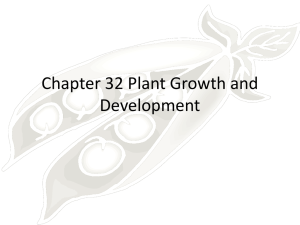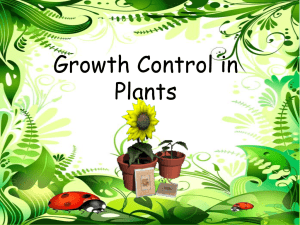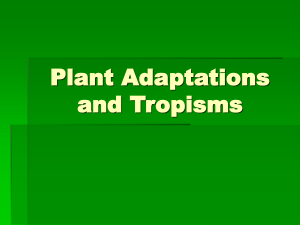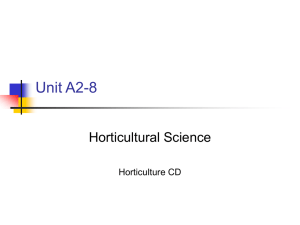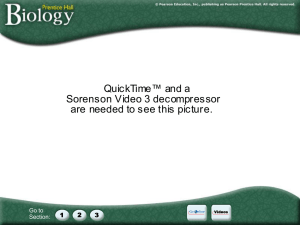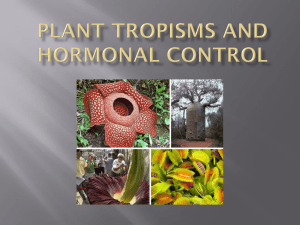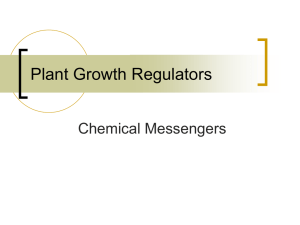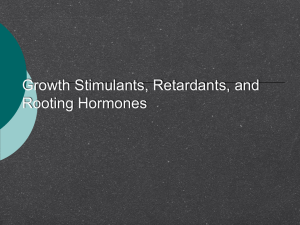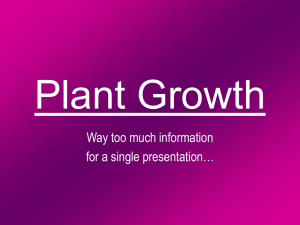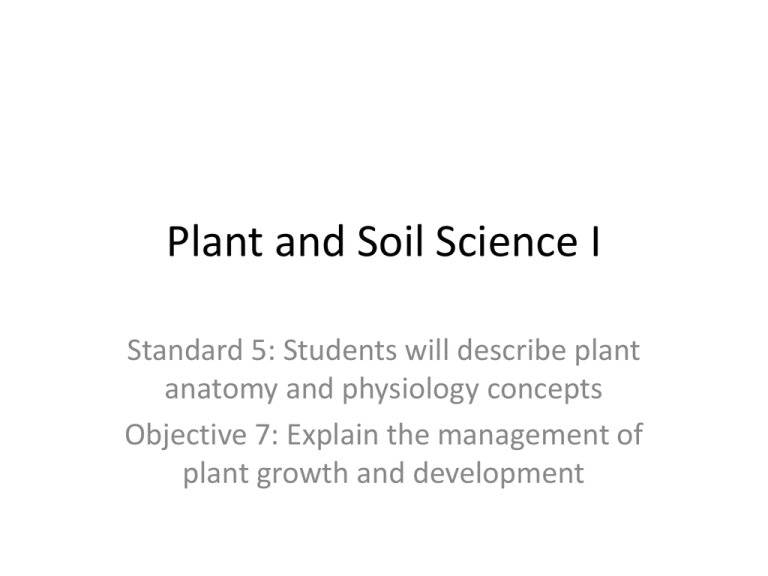
Plant and Soil Science I
Standard 5: Students will describe plant
anatomy and physiology concepts
Objective 7: Explain the management of
plant growth and development
Objectives
A. Describe the role of the apical meristem in plant
growth.
B. Identify plant hormones and explain their
functions.
C. Explain plant tropisms.
D. Differentiate between synthetic growth
regulators and plant hormones.
E. Describe the benefits of using plant growth
regulators.
A. Describe the role of the apical meristem in plant growth.
Meristems; a plants fountain of youth!
• Meristem: the site of actively dividing cells
resulting in plant growth
• Apical (or terminal) bud: located at the end of a
stem or root and gives the plant height or length
• Axillary (or lateral) bud: located on side of a stem
and give the plant girth
• Apical dominance: the apical tip grows taller and
longer inhibiting the growth of lateral buds
A. Describe the role of the apical meristem in plant growth.
A. Describe the role of the apical meristem in plant growth.
Meristems
• The meristimatic region on plants are found at
tip of the outer cells on roots or shoots
• Changing the apical dominance is as simple as
removing the top cells from a plant shoot
A. Describe the role of the apical meristem in plant growth.
Ouch, that hurt aka ‘pinching plants’
• Pinching plants is a form of pruning that
encourages branching
• Pinching plants alters the apical dominance
• Pinching the plant forces the plant to focus on
growing lost stems, rather than growing
height
A. Describe the role of the apical meristem in plant growth.
How to pinch plants
1. Find a node on the
plant you want to
pinch.
2. Using a knife,
scissors, or your
fingers remove
(pinch) the lateral
shoot above the
node.
B. Identify plant hormones and explain their functions.
Insulin
What are hormones?
Oestrogen
Glucagon
Chemical
Messenger
Testosterone
What is a hormone?
What do hormones do?
HGH
ADH
Causes a change
Travel in the Can you think of any
examples? in how the body
blood, secreted
works
by glands
Control Growth, blood sugar, sex
development, mood, metabolism.
B. Identify plant hormones and explain their functions.
Hormones in plants
What do hormones control in plants?
• Roots and shoots
• Seed germination
• Leaf fall
• Disease resistance
• Fruit formation and ripening
• Flowering time
• Bud formation
• Anything related to plant growth!
B. Identify plant hormones and explain their functions.
Hormones
• Naturally produced in the plant
• Some are commercially important and can be
used to to produce plants as ornaments or
food
• Some have different effects on different
tissues
B. Identify plant hormones and explain their functions.
Two types of hormones
• Promoters vs. Inhibitors
– Promoters- cause faster growth
– Inhibitors- reduce growth
• Also called a growth retardant
B. Identify plant hormones and explain their functions.
Hormones
•
•
•
•
•
Auxins
Gibberellins
Cytokinins
Ethylene
Abscisic acid
B. Identify plant hormones and explain their functions.
Hormones in a nutshell
Hormone
Effects
Auxins
Cell enlargement and differentiation
Giberellins
Cell enlargement and differentiation
Cytokinins
Cell division
Abscisic Acid
Ethylene
Dormancy
Ageing
B. Identify plant hormones and explain their functions.
Auxins
• Promote cell elongation
• One of the first hormones discovered in
science by Charles Darwin
• The primary auxin is indoleastic acid (IAA)
• There is a greater concentration of auxins in
the apical meristems, hence apical dominance
• Passed from cell to cell through their cell walls
• Promoter
B. Identify plant hormones and explain their functions.
Giberellins
• Induce cell elongation and cell division
• Produced in the stem and root apical
meristems, seed embryos and young leaves
• Important for plant growth and development
through flowering and/or seed germination
• Promoter
B. Identify plant hormones and explain their functions.
Cytokinins
• Responsible for cell division and
differentiation
• Produced in the roots and transported
through xylem
• Aid in growth of lateral shoots
• Inhibit branching of roots
• Promoter
B. Identify plant hormones and explain their functions.
Abscisic Acid
• Growth inhibiting hormone
• Plays a key role in seed dormancy
• Causes stomates to close in drought
conditions to conserve water
• Growth retardant
B. Identify plant hormones and explain their functions.
Ethylene
• Colorless gas that is emitted by aging plants
• It is produced in plant stems, ripening fruit
and dying leaves
• Converts starch into sugar
• Growth retardant
C. Explain plant tropisms.
Sensitivity – Responding to the environment
Plants respond to stimuli in order to:
• Avoid stress
• Avoid being eaten
• Enhance survival
• Improve chances of having offspring
• The way a plant grows is controlled by hormones
• Plants response to external stimuli is known as a
tropism
C. Explain plant tropisms.
The ‘tropisms’
•
•
•
•
•
Phototropism
Gravitropism or Geotropism
Chemotropism
Thigmitropism
Hydrotropism
C. Explain plant tropisms.
Stimulus vs. response
• Stimulus: something that influences an
activity
• Response: any behavior that results from the
stimulus
• Examples:
Stimulus
Response
Lack of food
Hungry
No water
Thirsty
Lollipops, ponies, and
Ferris wheels
Happy
C. Explain plant tropisms.
Step 1 – Make a copy of this table in your notes
Tropism
Phototropism
Gravitropism
Chemitropism
Thigmitropism
Hydrotropism
Stimulus
Response
C. Explain plant tropisms.
Step 2 – Observe the following pictures to complete the table
Tropism
Phototropism
Gravitropism
Chemitropism
Thigmitropism
Hydrotropism
Stimulus
Response
C. Explain plant tropisms.
C. Explain plant tropisms.
C. Explain plant tropisms.
Important minerals in soil
C. Explain plant tropisms.
C. Explain plant tropisms.
C. Explain plant tropisms.
Step 3 – Review your observations
Tropism
Stimulus
Response
Phototropism
Light source
Stems bend or stretch
(etiolation) towards light
Gravitropism
Gravity
Stems curve upward on a
plant that is laid on its side
Chemitropism
Nutrients in the soil
Roots grow to nutrients in
soil
Thigmitropism
Mechanical stimuli
Tendrils on a cucumber plant
touching an object and
curling around it for support
Hydrotropism
Water source
Roots grow to water
C. Explain plant tropisms.
What controls tropisms?
• The hormone auxin controls most tropisms
• Auxin promotes cell growth
• Phototropism
– Sunlight breaks down auxin
– Plant stems indirect sunlight will have the least
amount of auxin
– Area of the plant that is more shaded will have more
auxin
– More cell growth on shaded side
– Plant bends towards light
• Light directly over the plant
• Auxins are in equal quantity
• Cell elongation is equal on all
sides of the cell
• Greater light on the right side
of the plant
• Auxin quantity becomes
greater on the left cell
• Auxins trigger cell elongation
on the left side
• Plant ‘stretches’ to the light
C. Explain plant tropisms.
What controls tropisms?
• The hormone auxin controls most tropisms
• Auxin promotes cell growth
• Gravitropism
– The plant stem that was once upright is on its side
– The auxin are settle on the bottom side of the
stem
– More auxin accumulate on the stems bottom side
– More cell growth occurs on bottom side
– Plant bends upward
D. Differentiate between synthetic growth regulators and plant hormones.
What’s the difference?
• Plant growth regulators (PGR’s) modify the
plants physiological processes
• Hormones modify the plants physiological
processes
• One is created by the plant the other is
created in a factory!
D. Differentiate between synthetic growth regulators and plant hormones.
Natural vs. Synthetic
• Natural vs. Synthetic
– Natural- found naturally in plants
– Synthetic- human made
• Both groups regulate or influence:
– Cell division
– Cell differentiation
– Root and shoot growth
– Senescence (plant aging)
D. Differentiate between synthetic growth regulators and plant hormones.
Types of PGR’s
• Promoters vs. Inhibitors
– Promoters- cause faster growth
– Inhibitors- reduce growth
• Used on florist crops such as poinsettia &
chrysanthemum.
– They slow elongation of stems, making sturdier, fuller plants
• PGR’s have been created to model plant
hormones
D. Differentiate between synthetic growth regulators and plant hormones.
PGR’s
• Growth retardants can be used on hedges and lawns
to slow growth and decrease maintenance.
TREATED
UNTREATED
D. Differentiate between synthetic growth regulators and plant hormones.
Synthetic and natural growth retardants
• Synthetic and natural growth retardants are
sold under the trade names A-Rest®, B-Nine®,
Bonzi®, Sumagic®, Cycocel®, and others
• The different names are used on different
horticulture plants
E. Describe the benefits of using plant growth regulators.
Improve the quality and quantity
• Plant growth regulators improve the quality
and quantity of agriculture commodity yields
• Most of the plant growth regulators are
naturally produced by the plant
E. Describe the benefits of using plant growth regulators.
Auxins
• Speed up the rooting of plant cuttings
– Indoleacetic acid (IAA)
– Indolebutyric acid (IBA)
• Prevent pre-harvest fruit drop on apples
– Naphthaleneacetic acid (NAA)
E. Describe the benefits of using plant growth regulators.
Gibberellins
• Induces flowering
• Growth stimulant to make larger stalks and
fruit
E. Describe the benefits of using plant growth regulators.
Ethylene
• Promotes fruit ripening
• Used for ripening fruit before it is placed on
grocery shelves
• Pineapples will bloom when treated with
ethylene.
– In commercial greenhouses, the product used for
ethylene generation is Florel® or ethephon.
E. Describe the benefits of using plant growth regulators.
Cytokinins
• Cytokinins promote cell division and
enlargement to promote senescence
• Leaves grow themselves to death
E. Describe the benefits of using plant growth regulators.
Plant growth regulators
• Prevents lodging in cereal crops
• Prevents pre-harvest fruit drop
• Synchronizes maturity to allow mechanical
harvesting
• Harvesting maturity to decrease turnover time
• Historically common PGR’s
– 2-4D
– 2-4-5T (agent orange)
E. Describe the benefits of using plant growth regulators.
Pinching agents
• Pinching agent chemicals are used
commercially to kill terminal vegetative buds.
– They promote branching & a more bushy,
attractive plant.
• OffShoot-0® & Atrimmec® are mainly used for this
purpose.
E. Describe the benefits of using plant growth regulators.
Vitamins
• Vitamins are sold occasionally as stimulants for plant
growth and for use after transplanting
• Vitamin effectiveness has not been determined fully
– Limited experiments
• Overall, it is very possible that vitamins do improve
plant growth in some cases
– They should never be used in place of fertilizers or
proven-effective chemicals sold for use on plants

